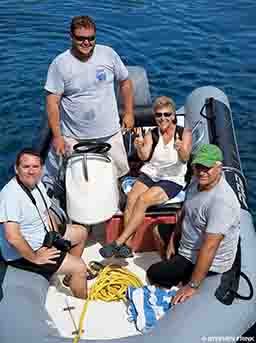
We had been counting down the days until our trip to Roatan, Honduras, and our first liveaboard experience. Our week started wonderfully. The diving was good, the crew was accommodating, and the other passengers were fun to be with.
On our fourth day of diving, my husband and I did three relatively aggressive dives. When we returned to the boat after the third dive, I felt a pain in my upper left chest as I was getting out of my wetsuit. Along with the pain was a small rash.
At first I thought it might be an allergic reaction to a marine sting, but I did not know how something could have gotten under my wetsuit. Over the next 10 to 15 minutes the rash spread down the front of my chest and to the upper part of my left arm. At this point the pain was becoming severe, and for a moment I thought it could be cardiac related. I took two acetaminophen and waited, but when I developed a persistent cough a short time later, we decided to inform the crew.
Our cruise director, Jonathan Staber, and trip organizer, Stephen Frink, examined the rash and concluded rather quickly that it looked like cutaneous decompression sickness (skin bends). I jokingly asked for a second opinion, so we took pictures of the affected area and sent them to DAN®. Frink followed up with a call to DAN.
The physician who saw the pictures agreed with the assessment and recommended oxygen first aid. The crew helped me get comfortable, administered high-flow oxygen through a mask and told me I would not be diving anymore this week. I could not believe it.
We were near Anthony’s Key Resort, where there is a clinic with a hyperbaric chamber, so DAN recommended I be transported there for additional care. DAN even contacted the clinic so the staff would be ready for us when we arrived. I boarded the zodiac along with Staber, another crew member and my husband, David. At that time I had been breathing oxygen for approximately 30 minutes. The pain and cough had greatly subsided, and the rash had stopped spreading.
Two staff members from the chamber met us at the dock and escorted us to the clinic, where Dr. Rafael Diaz was waiting for me. I explained the sequence of events and showed him my dive profiles on my computer. He performed a series of neurological exams and found no deficiencies.
Dr. Diaz recommended an additional hour of oxygen first aid and let me know I did not need be treated in the hyperbaric chamber, which came as a relief. Following the hour of breathing oxygen, the rash had subsided and the pain and cough were gone. Unfortunately, Dr. Diaz advised against diving for 30 days. Ouch!

He said that on rare occasions a less-severe rash would reappear after a few hours and requested a follow-up visit the next morning. I really appreciated the crew members from the liveaboard who stayed with me while I was being treated at the clinic. We all boarded the zodiac to return to the liveaboard, which the captain had kept near the clinic for us. As we traveled back, I was relieved that the skin bends were all but gone but saddened that I was finished diving for the duration of the trip.
The next morning Dr. Diaz performed another neurological assessment and did not identify any problems. He was pleased to see the rash was gone and reiterated that I should not dive for 30 days.
I have been diving since 2004, with more than 1,000 dives logged, and I am in very good physical condition. I keep myself well hydrated and avoid alcohol. On that particular day our dives had taken us a bit deep: The first was to 112 feet, and the second and third were to 80 feet. I did all three with 32 percent nitrox, and I stayed well within my no-decompression limits. So why did I get skin bends?
When I asked Dr. Diaz, he said any number of factors could have been involved, including patent foramen ovale (PFO), a hole between the two sides of the heart. Once home, I followed up with a cardiologist, who ordered an echocardiogram with contrast (a “bubble test”). The cardiologist found nothing of note, which was rather unsatisfying. I have since learned that decompression sickness is probabilistic — i.e., a numbers game. In most cases no underlying cause — beyond time and depth — can be identified. My future dives will involve strategies to increase conservatism, such as diving with nitrox while using air tables.

It took only one phone call for DAN to spring into action. Just one! They responded promptly with an assessment and advised a course of action. I knew I was in good hands, never doubting the treatment I was receiving. I cannot say enough good things about having DAN insurance.
I heartily recommend DAN membership and dive-accident insurance to everyone who dives, especially after this experience. DAN was definitely there for me!

| © Alert Diver — Q1 2018 |